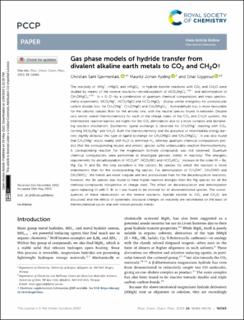| dc.contributor.author | Gjermestad, Christian Sant | |
| dc.contributor.author | Ryding, Mauritz Johan Olof | |
| dc.contributor.author | Uggerud, Einar | |
| dc.date.accessioned | 2024-03-26T13:36:14Z | |
| dc.date.available | 2024-03-26T13:36:14Z | |
| dc.date.created | 2023-06-26T10:25:09Z | |
| dc.date.issued | 2023 | |
| dc.identifier.issn | 1463-9076 | |
| dc.identifier.uri | https://hdl.handle.net/11250/3124261 | |
| dc.description.abstract | The reactivity of HMg+, HMgCl, and HMgCl2− in hydride transfer reactions with CO2 and CH2O were studied by means of the reverse reactions—decarboxylation of HCO2MgCln+/0/− and deformylation of CH3OMgCln+/0/− (n = 0–2)—by a combination of quantum chemical computations and mass spectrometry experiments. HCO2Mg+, HCO2MgCl and HCO2MgCl2− display similar energetics for unimolecular carbon dioxide loss; for CH3OMg+, CH3OMgCl and CH3OMgCl2−, formaldehyde loss is more favourable for the cationic species than for the anionic one, with the neutral species found in-between. Despite very similar overall thermochemistry for each of the charge states of the CO2 and CH2O systems, the intermediate reaction barriers are higher for the CO2 eliminations due to a more complex and demanding reaction mechanism. Exothermic ligand exchange is observed for CH3OMg+ reacting with CO2, forming HCO2Mg+ and CH2O. Both the thermochemistry and the presence of intermediate energy barriers slightly disfavour this type of ligand exchange for CH3OMgCl and CH3OMgCl2−. It was also found that CH3OMg+ reacts readily with H2O to eliminate H2, whereas quantum chemical computations predict that the corresponding neutral and anionic species suffer unfavourable reaction thermochemistry. A corresponding reaction for the magnesium formate compounds was not observed. Quantum chemical computations were performed to investigate periodic trends in reactivity. The energetic requirements for decarboxylation of HCO2M+, HCO2MCl and HCO2MCl2− increase in the order M = Be, Mg, Ca, Sr and Ba; the only exception is the cationic Be species for which the reaction is more endothermic than for the corresponding Mg species. For deformylation of CH3OM+, CH3OMCl and CH3OMCl2− the trends are more irregular and less pronounced than for the decarboxylation reactions; however, the Be species was found to have higher reaction energies than the Mg species for all the methoxy-compounds irrespective of charge state. The effect on decarboxylation and deformylation upon replacing Cl with F, Br or I was found to be minimal for all aforementioned species. The consequences of these observations on the reverse reactions, hydride transfer to CO2 and CH2O, are discussed, and the effects of systematic structural changes on reactivity are rationalized on the basis of thermochemical cycles and well-known periodic trends. | en_US |
| dc.language.iso | eng | en_US |
| dc.publisher | Royal Society of Chemistry | en_US |
| dc.rights | Navngivelse 4.0 Internasjonal | * |
| dc.rights.uri | http://creativecommons.org/licenses/by/4.0/deed.no | * |
| dc.title | Gas phase models of hydride transfer from divalent alkaline earth metals to CO2 and CH2O | en_US |
| dc.type | Journal article | en_US |
| dc.type | Peer reviewed | en_US |
| dc.description.version | publishedVersion | en_US |
| cristin.ispublished | true | |
| cristin.fulltext | postprint | |
| cristin.qualitycode | 2 | |
| dc.identifier.doi | 10.1039/d2cp05964a | |
| dc.identifier.cristin | 2157850 | |
| dc.source.journal | Physical Chemistry, Chemical Physics - PCCP | en_US |
| dc.source.pagenumber | 16065-16076 | en_US |
| dc.identifier.citation | Physical Chemistry, Chemical Physics - PCCP. 2023, 2023 (25), 16065-16076. | en_US |
| dc.source.volume | 2023 | en_US |
| dc.source.issue | 25 | en_US |

